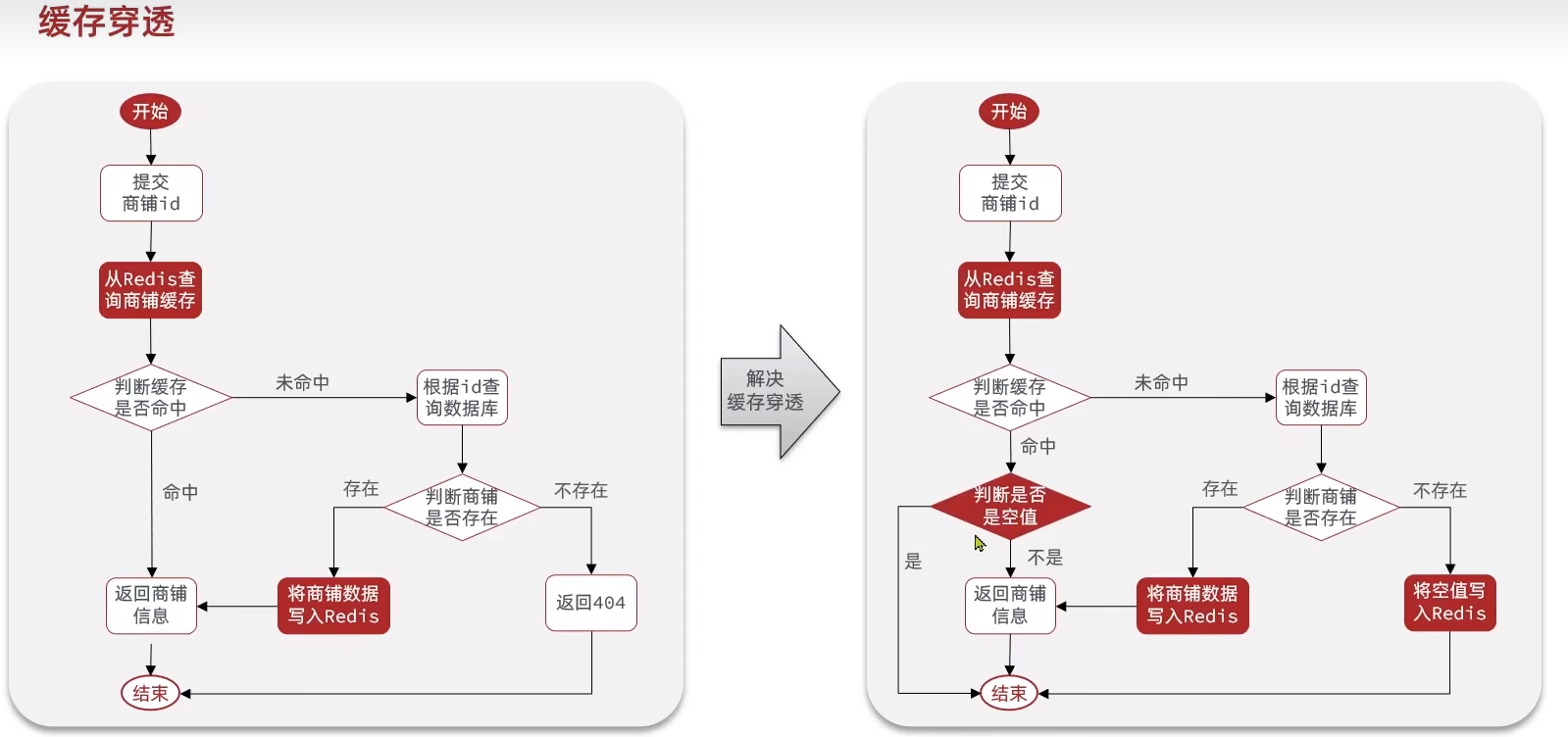本文主要是介绍Redis——某马点评day02——商铺缓存,希望对大家解决编程问题提供一定的参考价值,需要的开发者们随着小编来一起学习吧!
什么是缓存

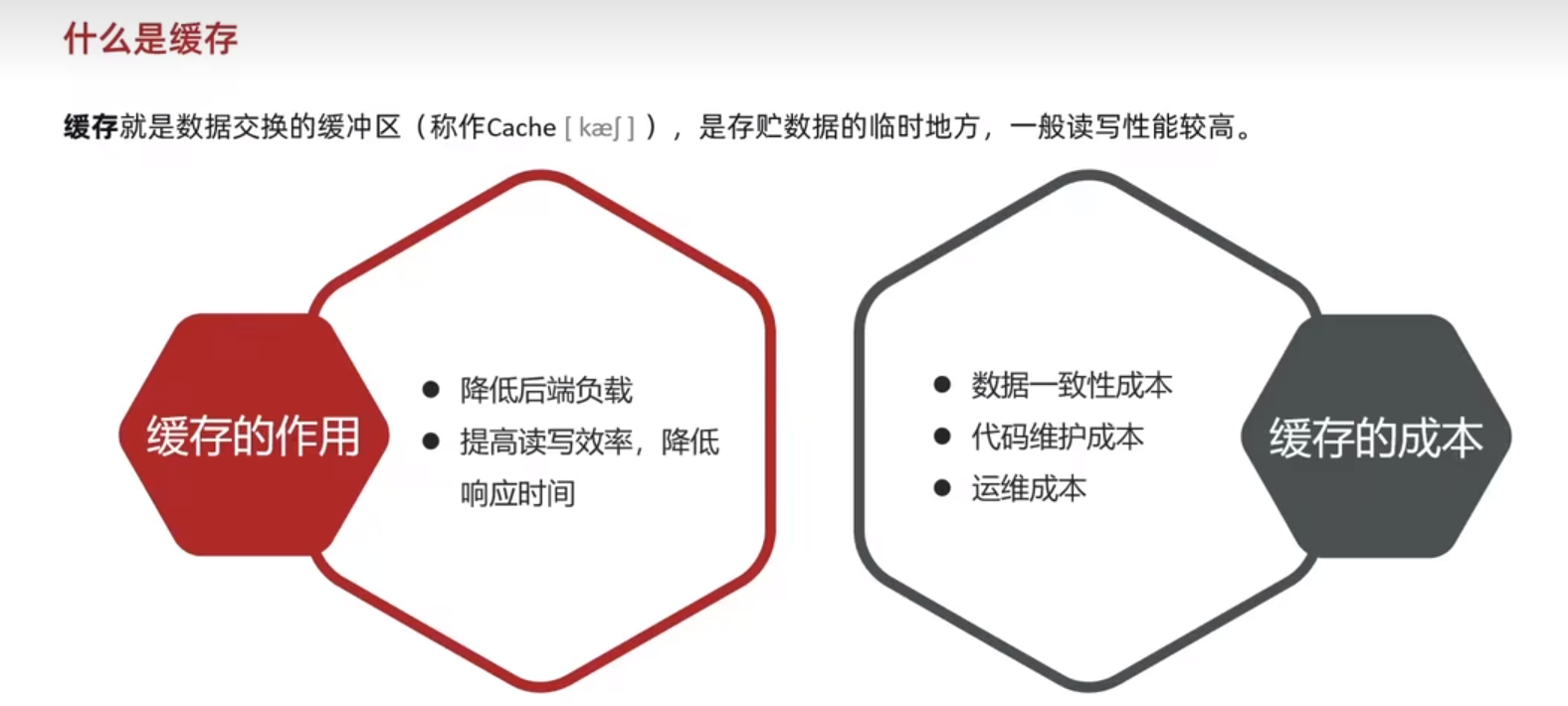
添加Redis缓存
添加商铺缓存

Controller层中
/*** 根据id查询商铺信息* @param id 商铺id* @return 商铺详情数据*/@GetMapping("/{id}")public Result queryShopById(@PathVariable("id") Long id) {return shopService.queryById(id);}Service层中
*/
@Service
public class ShopServiceImpl extends ServiceImpl<ShopMapper, Shop> implements IShopService {@Resourceprivate StringRedisTemplate stringRedisTemplate;@Overridepublic Result queryById(Long id) {String key="cache:shop:" + id;//1.从Redis查询缓存String shopJson = stringRedisTemplate.opsForValue().get(key);//2.判断是否存在if (StrUtil.isNotBlank(shopJson)) {//3.存在,直接返回Shop shop = JSONUtil.toBean(shopJson, Shop.class);return Result.ok(shop);}//4.不存在,根据id查询数据库Shop shop = getById(id);if (shop==null) {//5.不存在,返回错误return Result.fail("店铺不存在");}//6.存在,写入RedisstringRedisTemplate.opsForValue().set(key,JSONUtil.toJsonStr(shop));//7.返回return Result.ok(shop);}
}练习添加店铺类型缓存
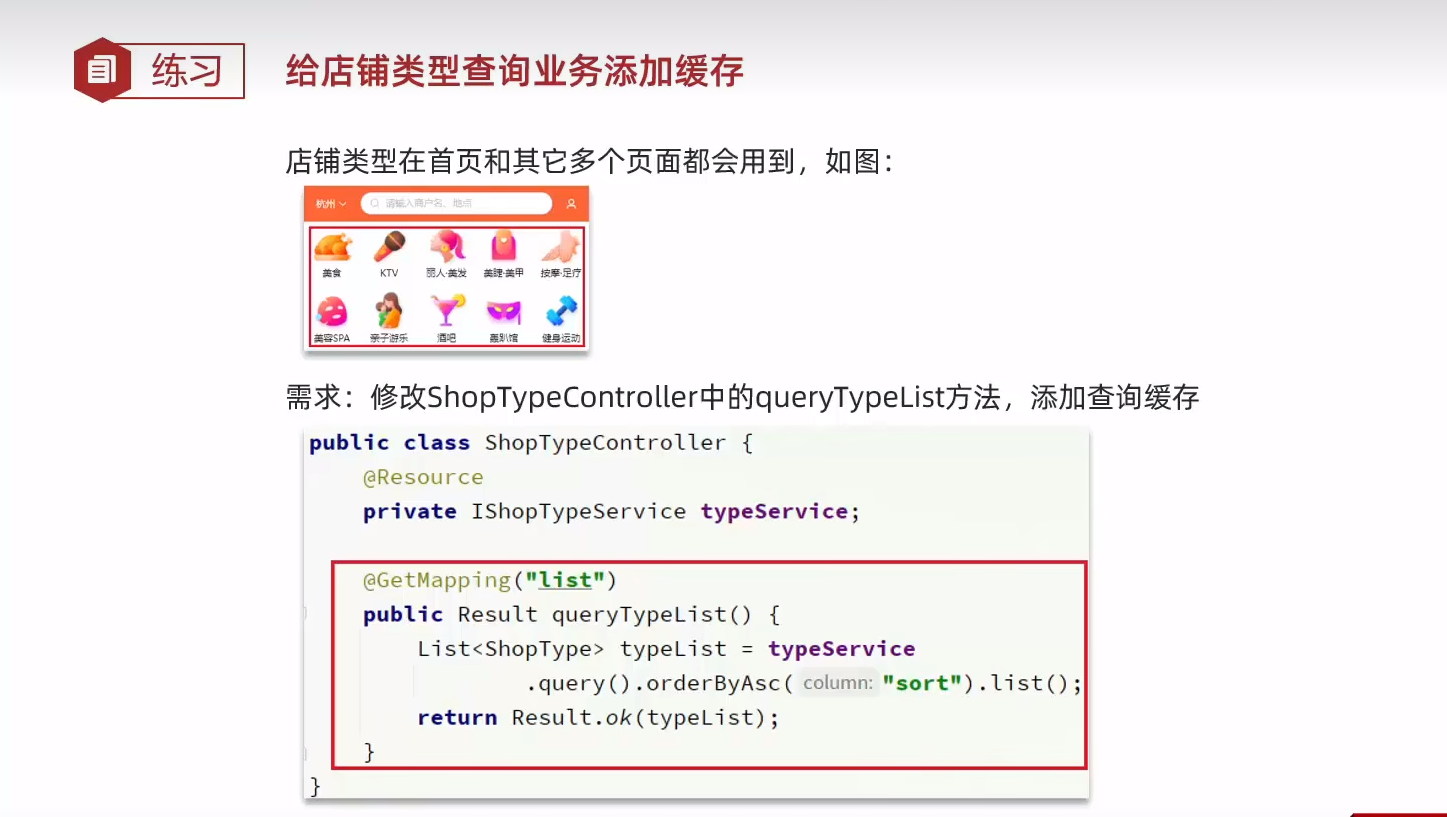 Controller层中
Controller层中
@RestController
@RequestMapping("/shop-type")
public class ShopTypeController {@Resourceprivate IShopTypeService typeService;@GetMapping("list")public Result queryTypeList() {return typeService.queryTypeList();}
}
Service层中
@Overridepublic Result queryTypeList() {String key="cache:shopType";//1.从Redis查询缓存String shopType = stringRedisTemplate.opsForValue().get(key);//2.判断是否存在if (StrUtil.isNotBlank(shopType)) {//3.存在,直接返回List<ShopType> typeList = JSONUtil.toList(shopType, ShopType.class);return Result.ok(typeList);}//4.不存在,查询数据库List<ShopType> typeList = query().orderByAsc("sort").list();//5.存在,写入RedisstringRedisTemplate.opsForValue().set(key,JSONUtil.toJsonStr(typeList));//7.返回return Result.ok(typeList);}缓存更新策略
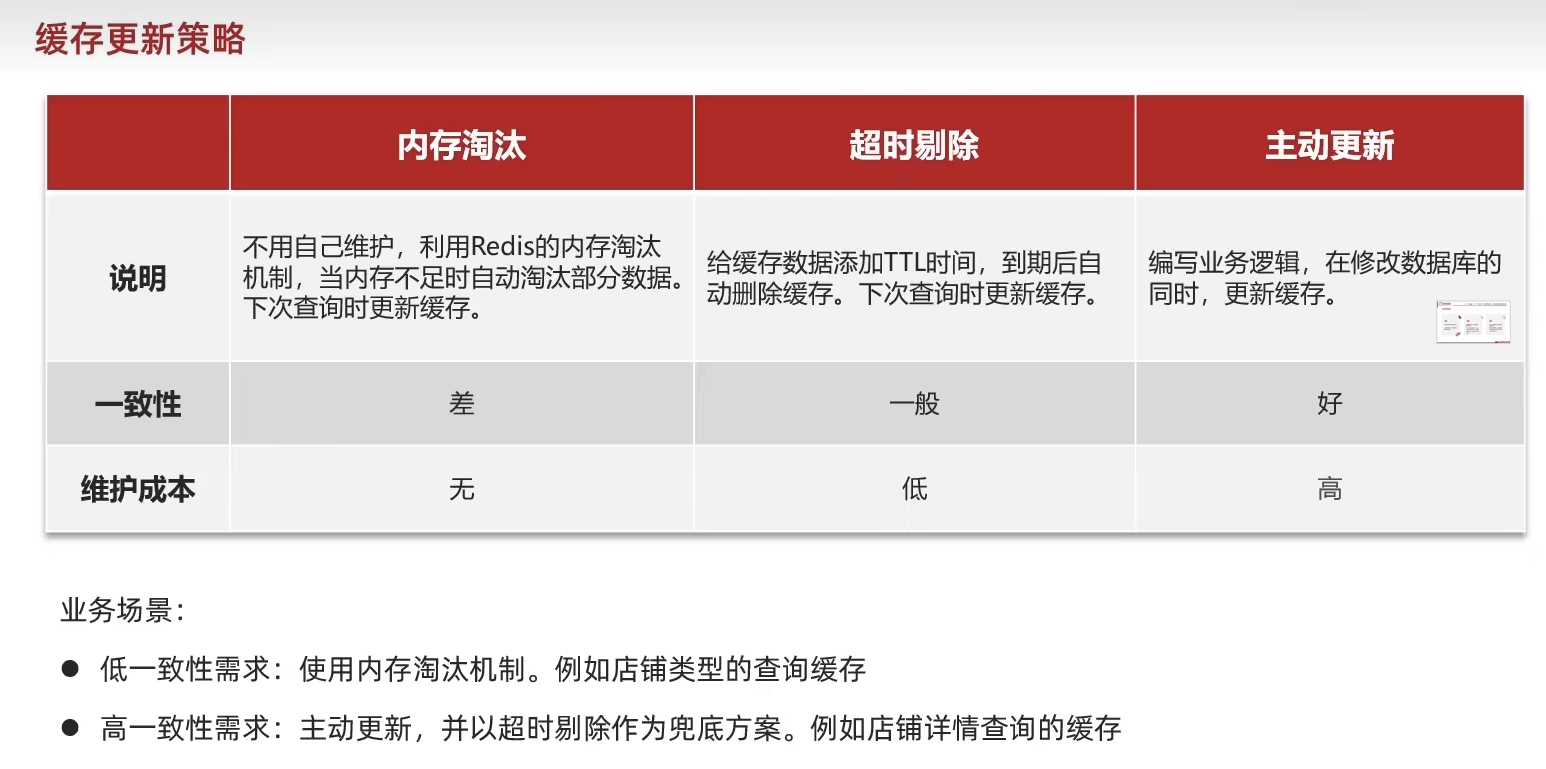
 通常选择的方案都是第一种
通常选择的方案都是第一种
单体系统可以通过@Transactional注解完成事务。
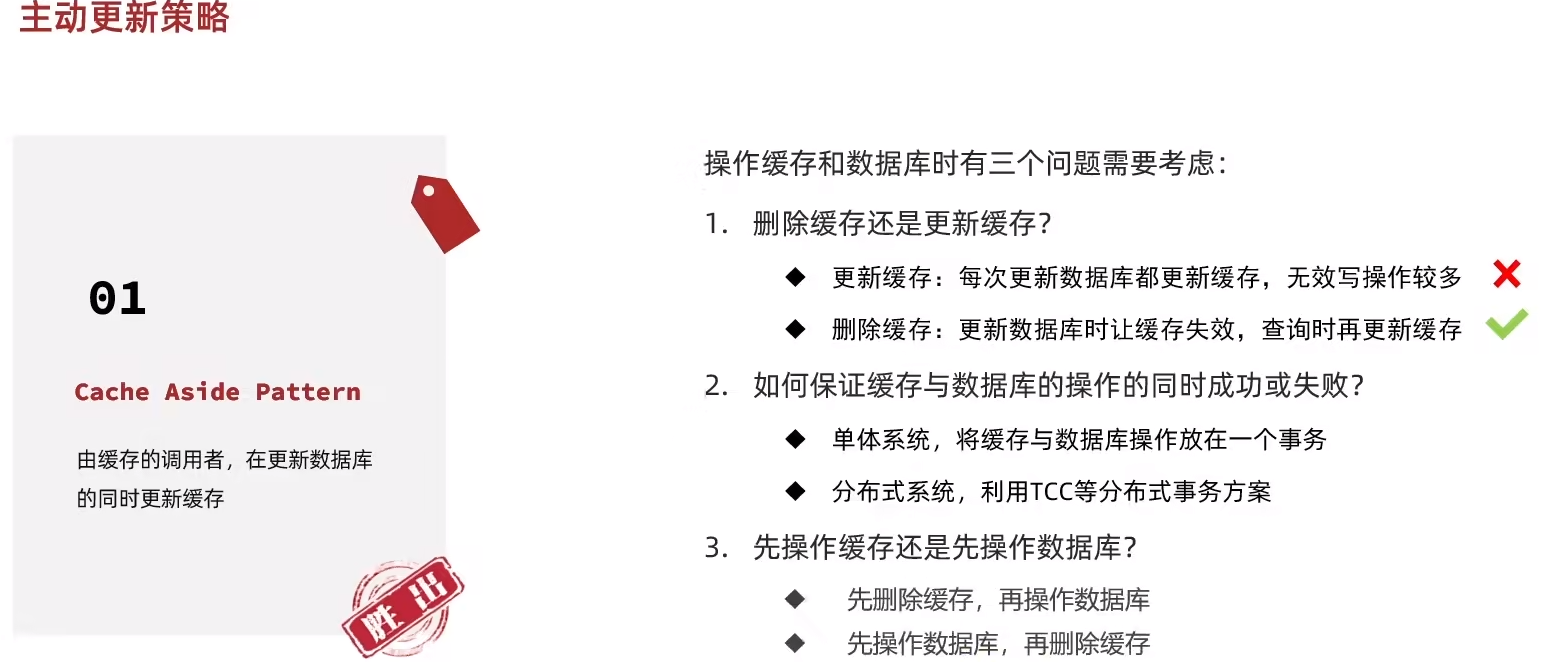
通常是先操作数据库,再删除缓存,出现问题的几率极小。
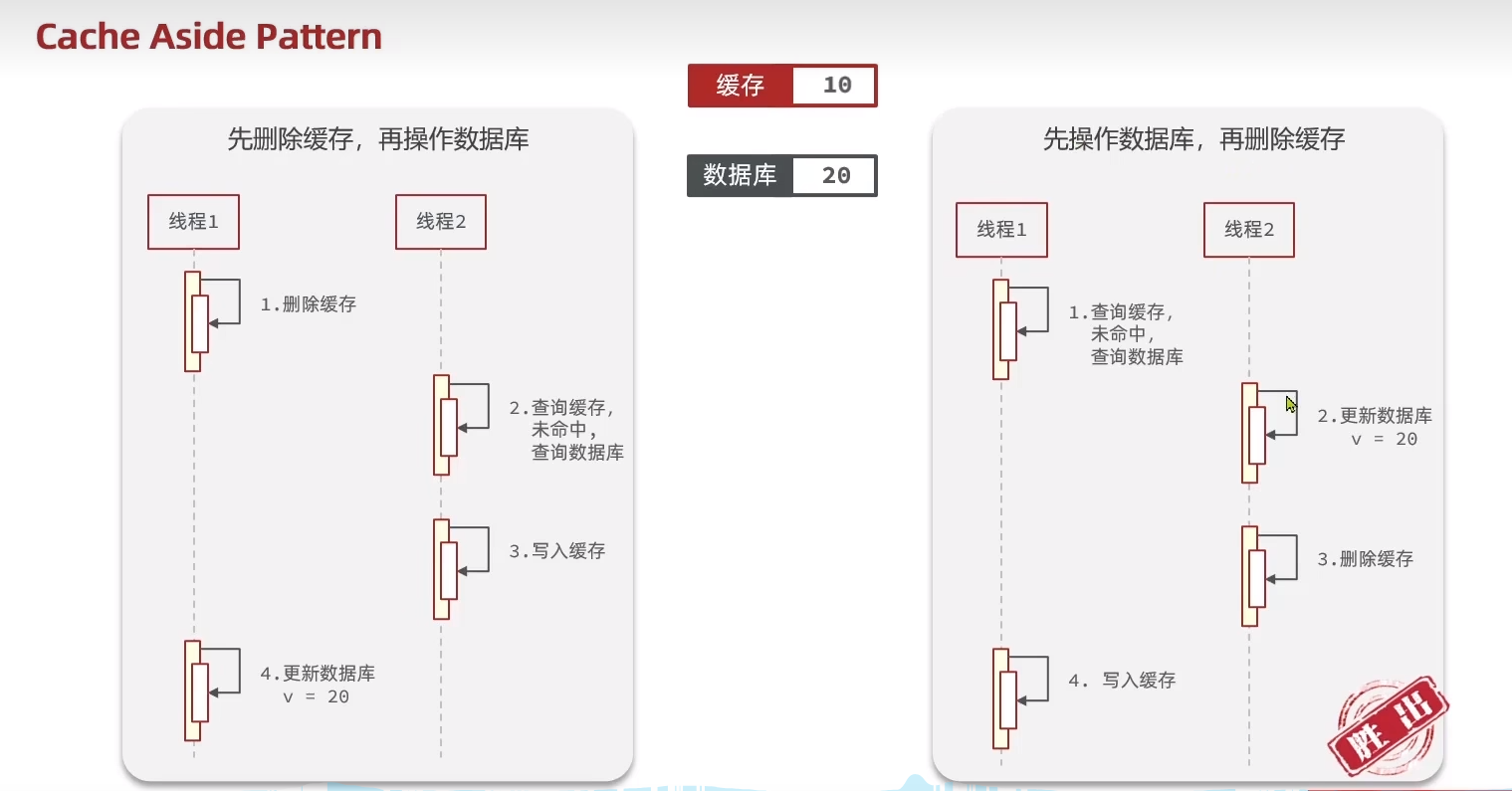
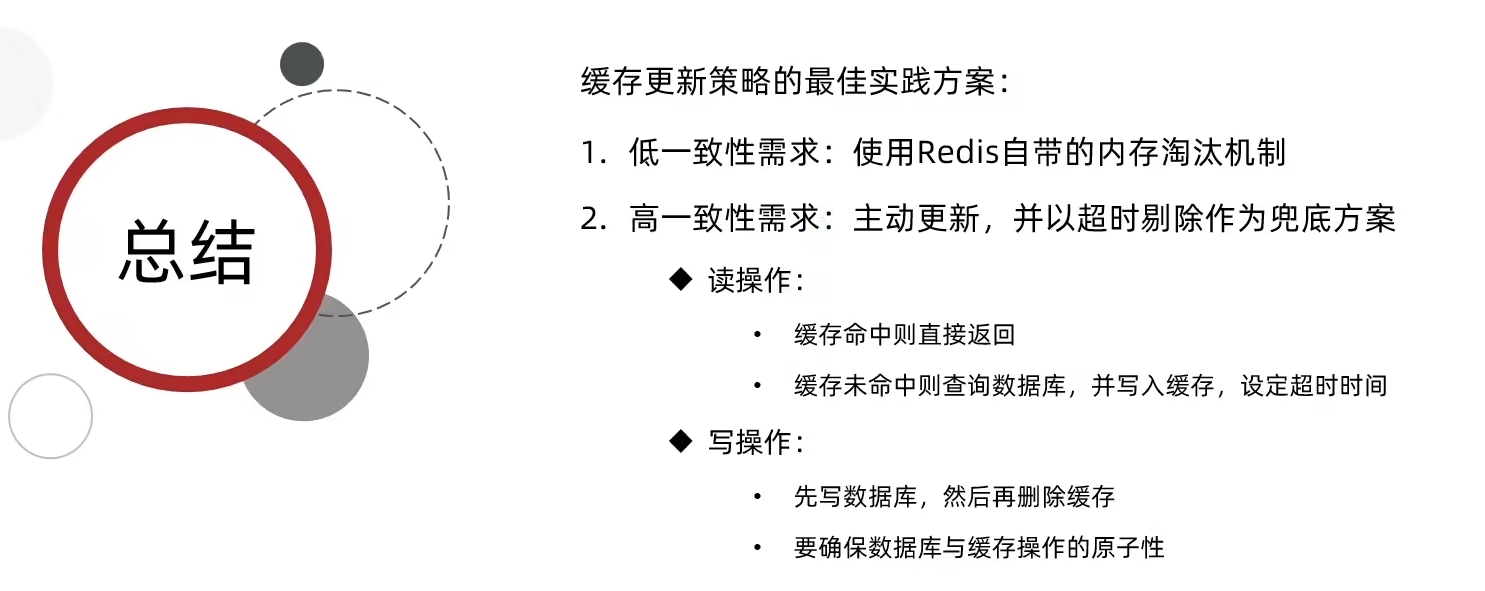
实现商铺缓存和数据库的双写一致

第一个地方,写入Redis时加上超时时间。
//6.存在,写入RedisstringRedisTemplate.opsForValue().set(key,JSONUtil.toJsonStr(shop),CACHE_SHOP_TTL, TimeUnit.MINUTES);第二个地方
controller中
/*** 更新商铺信息* @param shop 商铺数据* @return 无*/@PutMappingpublic Result updateShop(@RequestBody Shop shop) {return shopService.update(shop);}service中
@Overridepublic Result update(Shop shop) {Long id = shop.getId();if(id==null){return Result.fail("店铺id不能为空");}//1.更新数据库updateById(shop);//2.删除缓存stringRedisTemplate.delete(CACHE_SHOP_KEY+id);return null;}缓存穿透
布隆过滤器的实现不是真的存储数据,而是用某种Hash算法计算之后用二进制压缩之类的方法保存是否存在。但是,也有可能多个数据hash值相同导致错误结果。
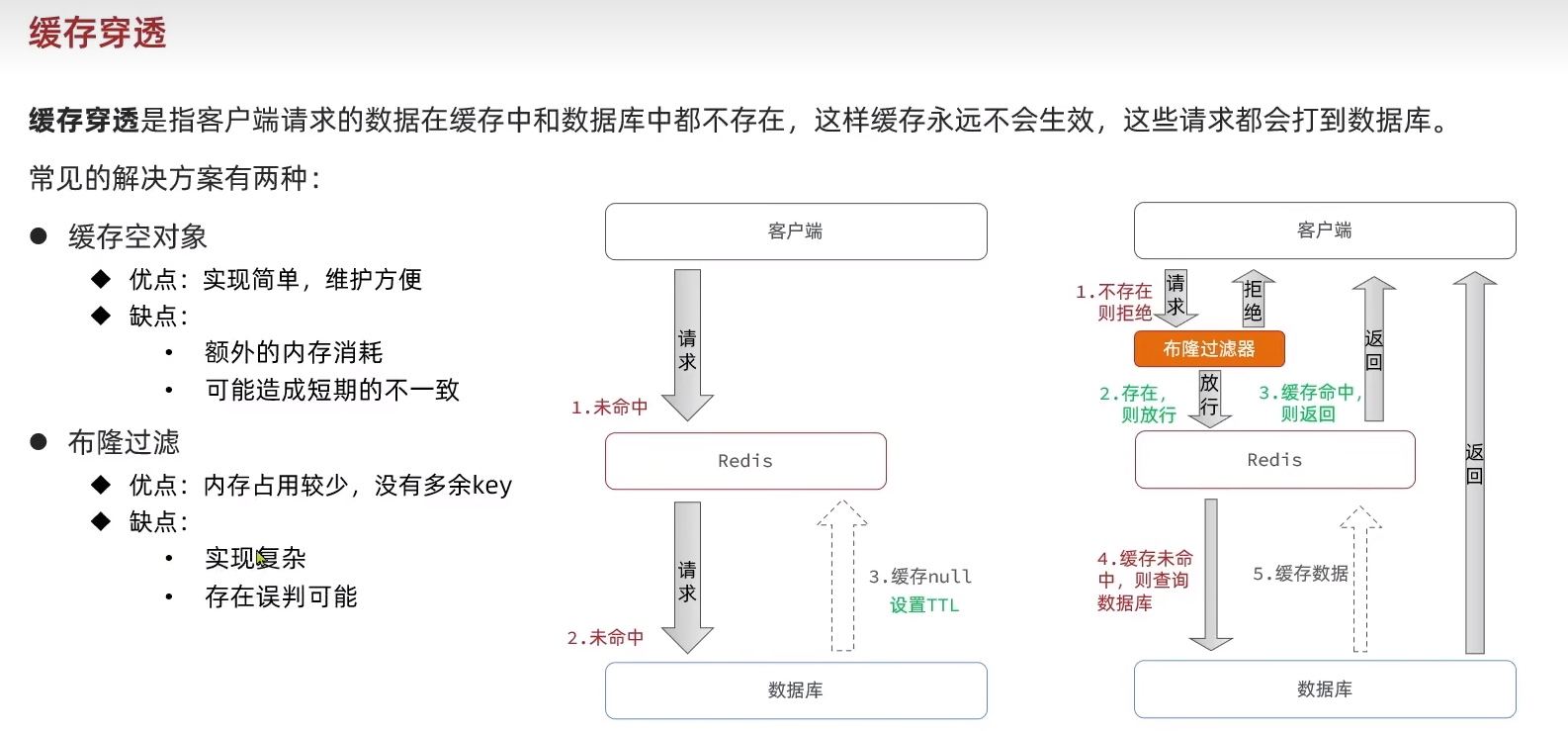
编码解决商铺查询的缓存穿透(缓存空对象做法)
代码修改
@Overridepublic Result queryById(Long id) {String key=CACHE_SHOP_KEY+ id;//1.从Redis查询缓存String shopJson = stringRedisTemplate.opsForValue().get(key);//2.判断是否存在if (StrUtil.isNotBlank(shopJson)) {//3.存在,直接返回Shop shop = JSONUtil.toBean(shopJson, Shop.class);return Result.ok(shop);}//判断命中的是否是空值if(shopJson!=null){//返回一个错误信息return Result.fail("店铺不存在");}//4.不存在,根据id查询数据库Shop shop = getById(id);if (shop==null) {//将空值写入RedisstringRedisTemplate.opsForValue().set(key,"",CACHE_NULL_TTL, TimeUnit.MINUTES);//5.不存在,返回错误return Result.fail("店铺不存在");}//6.存在,写入RedisstringRedisTemplate.opsForValue().set(key,JSONUtil.toJsonStr(shop),CACHE_SHOP_TTL, TimeUnit.MINUTES);//7.返回return Result.ok(shop);}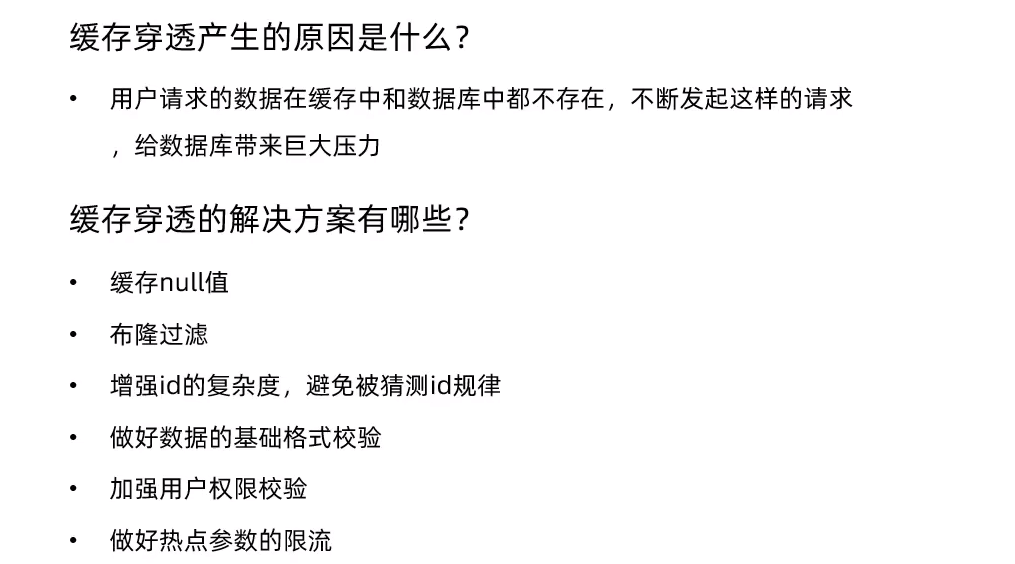 限流可以用sentinel实现.
限流可以用sentinel实现.
缓存雪崩
宕机时降级限流也是用sentinel实现。
nginx缓存也是一级缓存.
tmd,一直在说springcloud里面有讲。
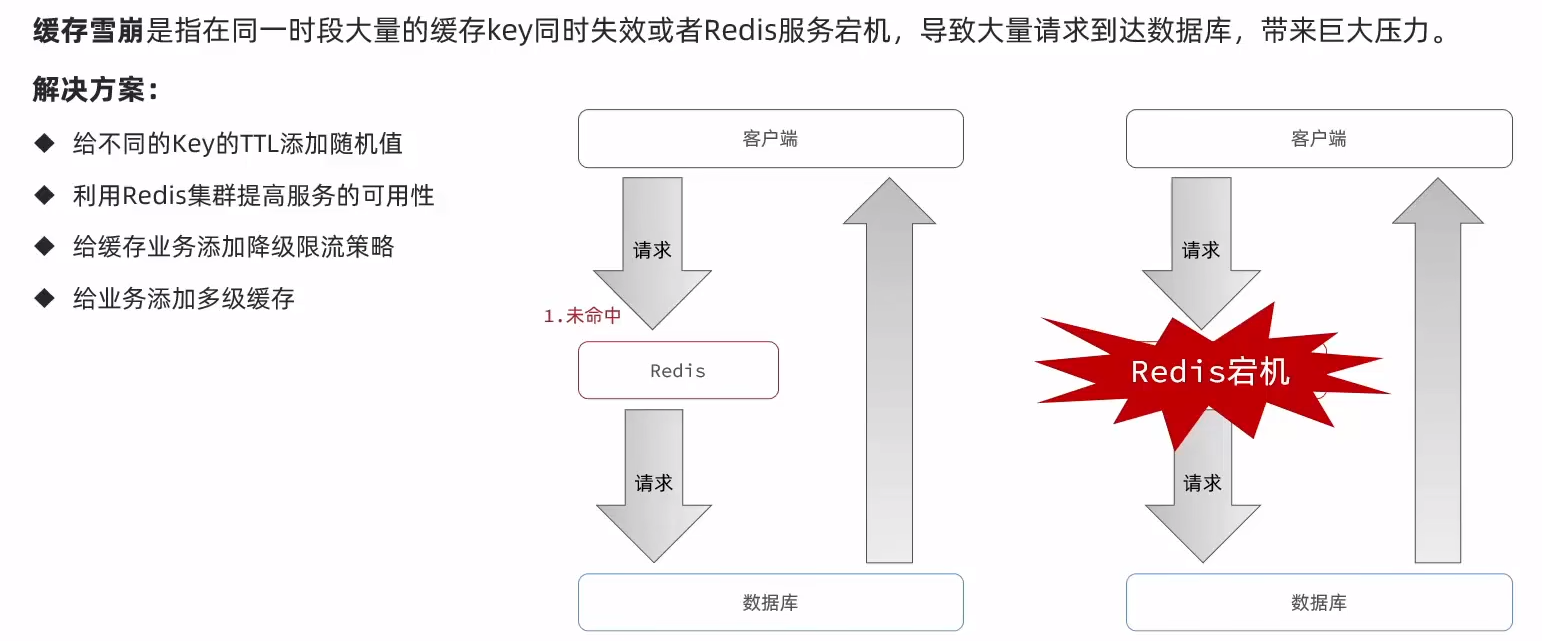
缓存击穿
常见解决方案
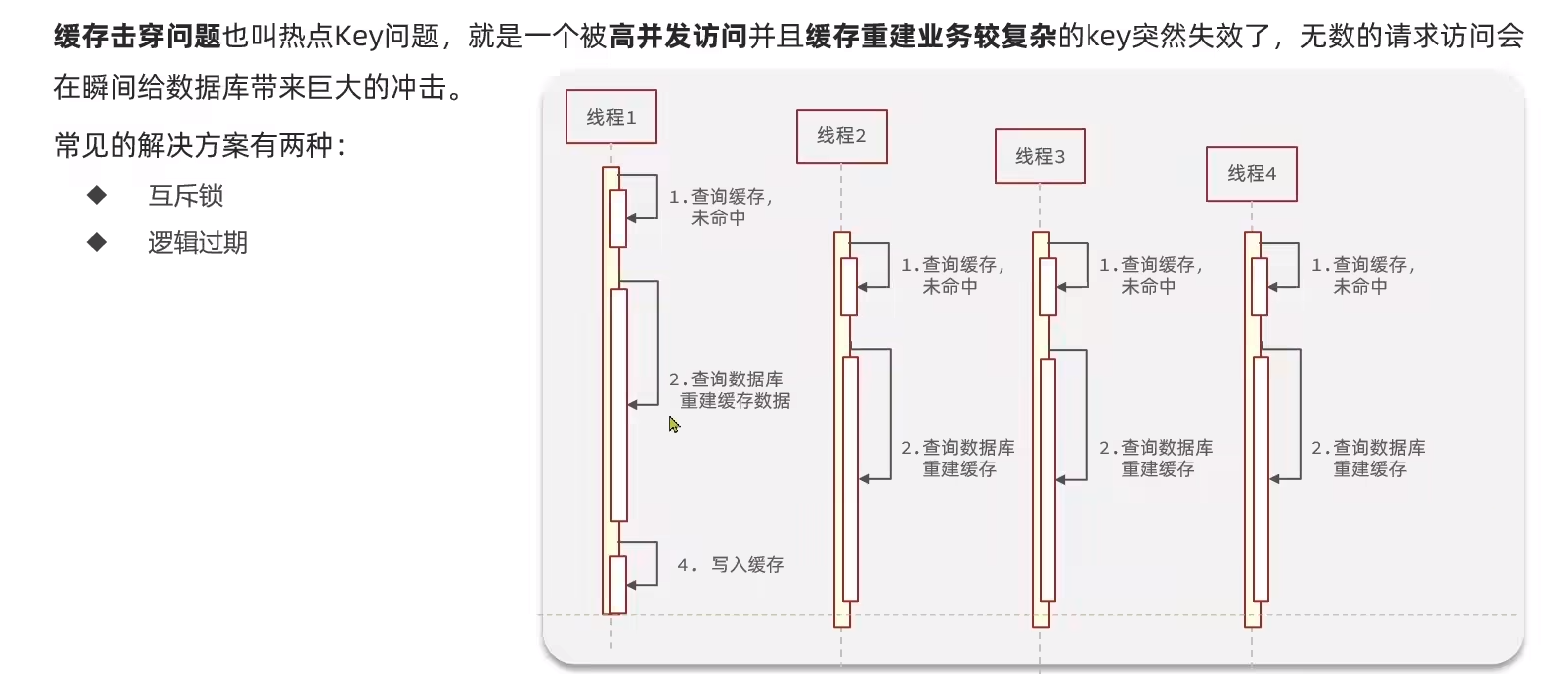
这里可以参考一下redisson的源码设计思路,设计一个监听通知机制!
逻辑过期解决方案不会设置ttl过期时间,而是新增一个exprie字段,从redis里面查询发现是过期数据时就需要加锁开启一个新线程去更新缓存,然后直接返回旧数据。有别的线程来获取锁失败时说明已经有线程在进行更新,所以就直接返回过期数据,避免了过多线程等待锁。

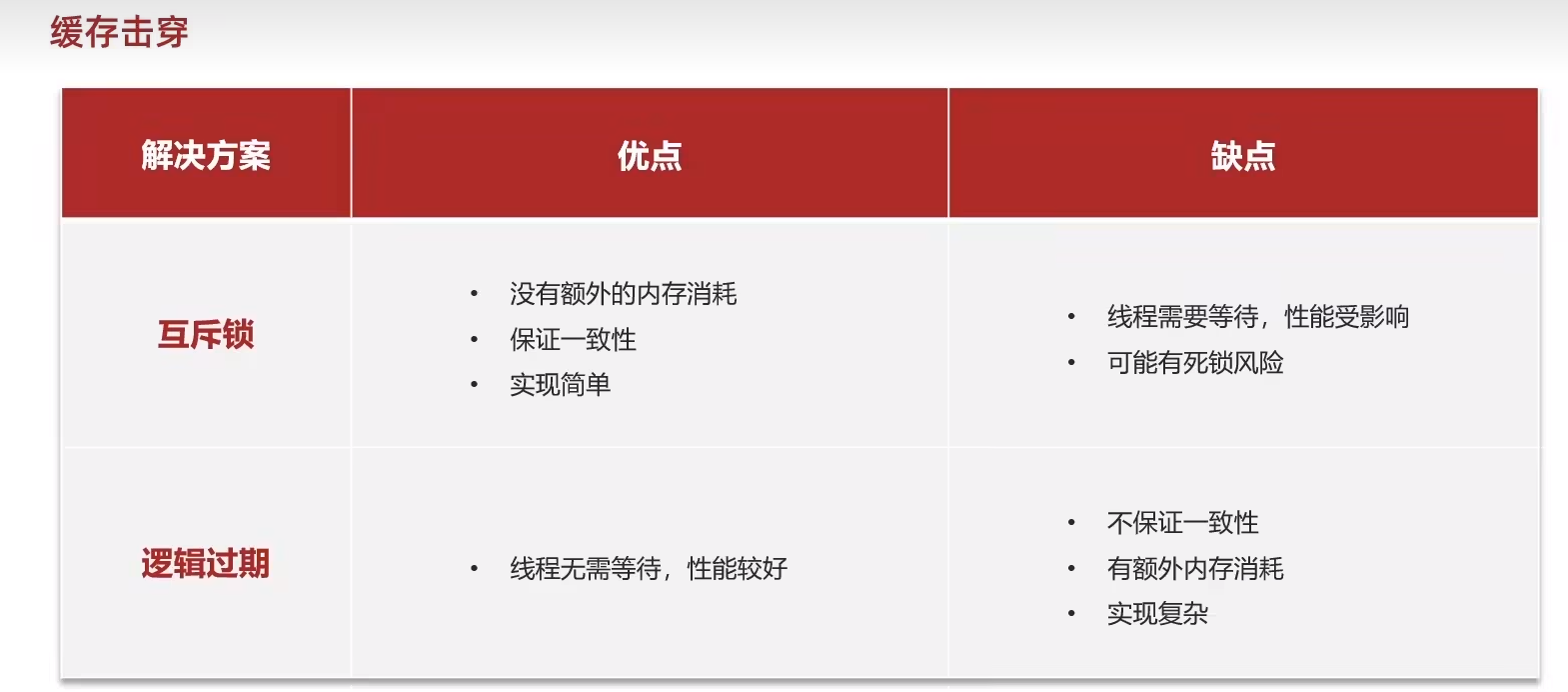
利用互斥锁解决缓存击穿问题(重点)

这里的锁不能用lock和synchronized进行互斥实现,这两个会一直等待.这里用到Redis的一个命令setnx, 这个是一旦设置之后就不能修改,只能删除,但是如果因为意外原因导致迟迟不能删除会有大问题,所以这里会给锁设置一个有效期.
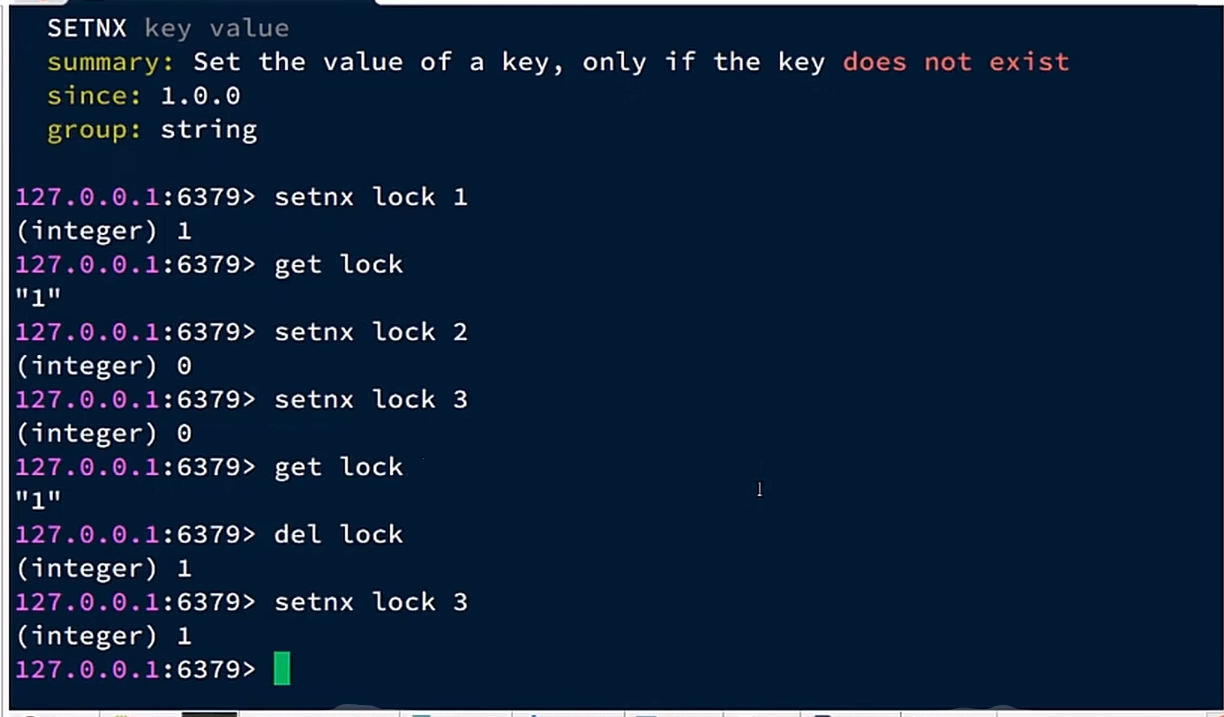
代码修改
@Service
public class ShopServiceImpl extends ServiceImpl<ShopMapper, Shop> implements IShopService {@Resourceprivate StringRedisTemplate stringRedisTemplate;@Overridepublic Result queryById(Long id) {//缓存穿透//Shop shop=queryWithPassThrouh(id);//互斥锁解决缓存击穿Shop shop = queryWithMutex(id);if(shop==null){return Result.fail("店铺不存在!");}//7.返回return Result.ok(shop);}public Shop queryWithMutex(Long id){String key=CACHE_SHOP_KEY+ id;//1.从Redis查询缓存String shopJson = stringRedisTemplate.opsForValue().get(key);//2.判断是否存在if (StrUtil.isNotBlank(shopJson)) {//3.存在,直接返回return JSONUtil.toBean(shopJson, Shop.class);}//判断命中的是否是空值if(shopJson!=null){//返回一个错误信息return null;}//4.实现缓存重建//4.1获取互斥锁String lockkey="lock:shop:"+id;Shop shop = null;try {boolean isLock = tryLock(lockkey);//4.2判断是否获取成功if(!isLock){//4.3失败,休眠并重试Thread.sleep(50);return queryWithMutex(id); //这里有可能会出现栈溢出的情况。}//获取成功之后应该再次检查缓存是否存在,有可能别的线程已经重建完了缓存,所以这里就无需再重建缓存shopJson = stringRedisTemplate.opsForValue().get(key);//再次判断是否存在if (StrUtil.isNotBlank(shopJson)) {//存在,直接返回return JSONUtil.toBean(shopJson, Shop.class);}//4.4根据id查询数据库shop = getById(id);//模拟重建的延时Thread.sleep(200);if (shop==null) {//将空值写入RedisstringRedisTemplate.opsForValue().set(key,"",CACHE_NULL_TTL, TimeUnit.MINUTES);//5.不存在,返回错误return shop;}//6.存在,写入RedisstringRedisTemplate.opsForValue().set(key,JSONUtil.toJsonStr(shop),CACHE_SHOP_TTL, TimeUnit.MINUTES);} catch (InterruptedException e) {throw new RuntimeException(e);} finally {//7.释放互斥锁unlock(lockkey);}//8.返回return shop;}public Shop queryWithPassThrouh(Long id){String key=CACHE_SHOP_KEY+ id;//1.从Redis查询缓存String shopJson = stringRedisTemplate.opsForValue().get(key);//2.判断是否存在if (StrUtil.isNotBlank(shopJson)) {//3.存在,直接返回Shop shop = JSONUtil.toBean(shopJson, Shop.class);return shop;}//判断命中的是否是空值if(shopJson!=null){//返回一个错误信息return null;}//4.不存在,根据id查询数据库Shop shop = getById(id);if (shop==null) {//将空值写入RedisstringRedisTemplate.opsForValue().set(key,"",CACHE_NULL_TTL, TimeUnit.MINUTES);//5.不存在,返回错误return shop;}//6.存在,写入RedisstringRedisTemplate.opsForValue().set(key,JSONUtil.toJsonStr(shop),CACHE_SHOP_TTL, TimeUnit.MINUTES);//7.返回return shop;}private boolean tryLock(String key){Boolean flag = stringRedisTemplate.opsForValue().setIfAbsent(key, "1", 10, TimeUnit.SECONDS);return BooleanUtil.isTrue(flag);}private void unlock(String key){stringRedisTemplate.delete(key);}@Overridepublic Result update(Shop shop) {Long id = shop.getId();if(id==null){return Result.fail("店铺id不能为空");}//1.更新数据库updateById(shop);//2.删除缓存stringRedisTemplate.delete(CACHE_SHOP_KEY+id);return null;}
}这里可以上Jmeter进行压测,上100个线程进行测试
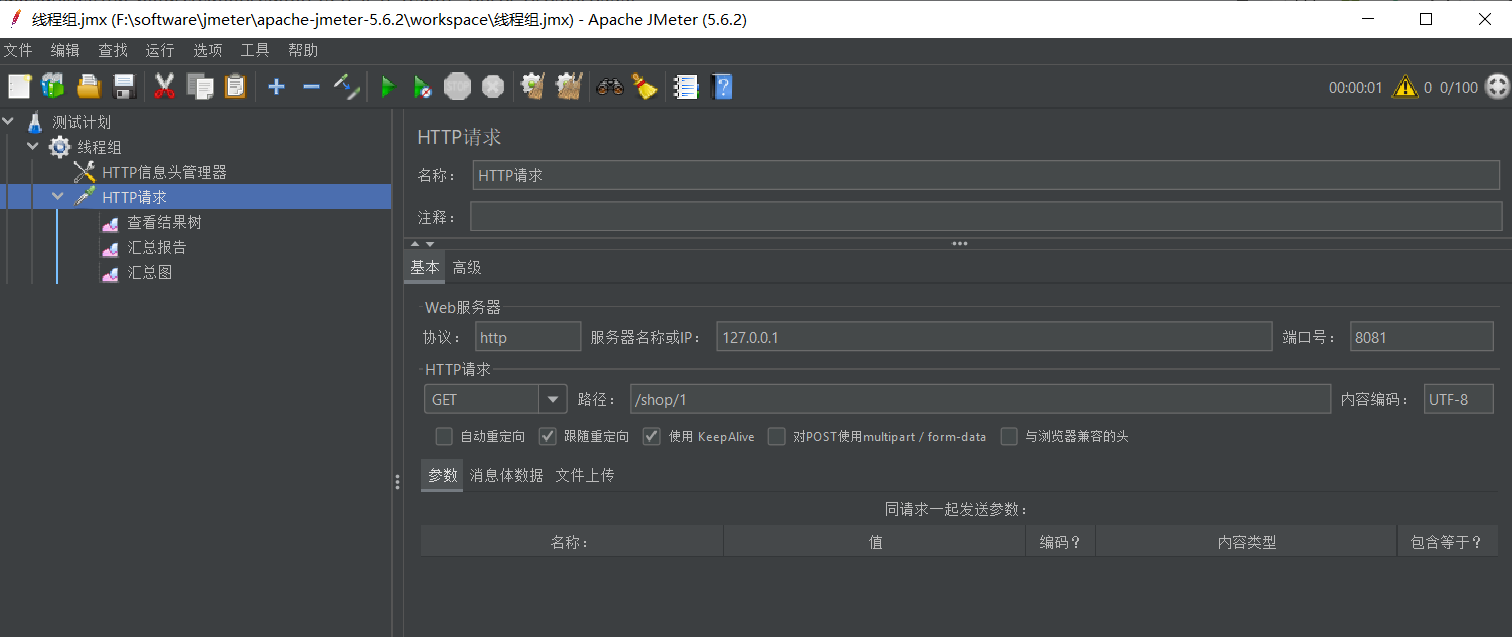
但是最终实际只查询了一次数据库.

利用逻辑过期解决缓存击穿问题(重点)
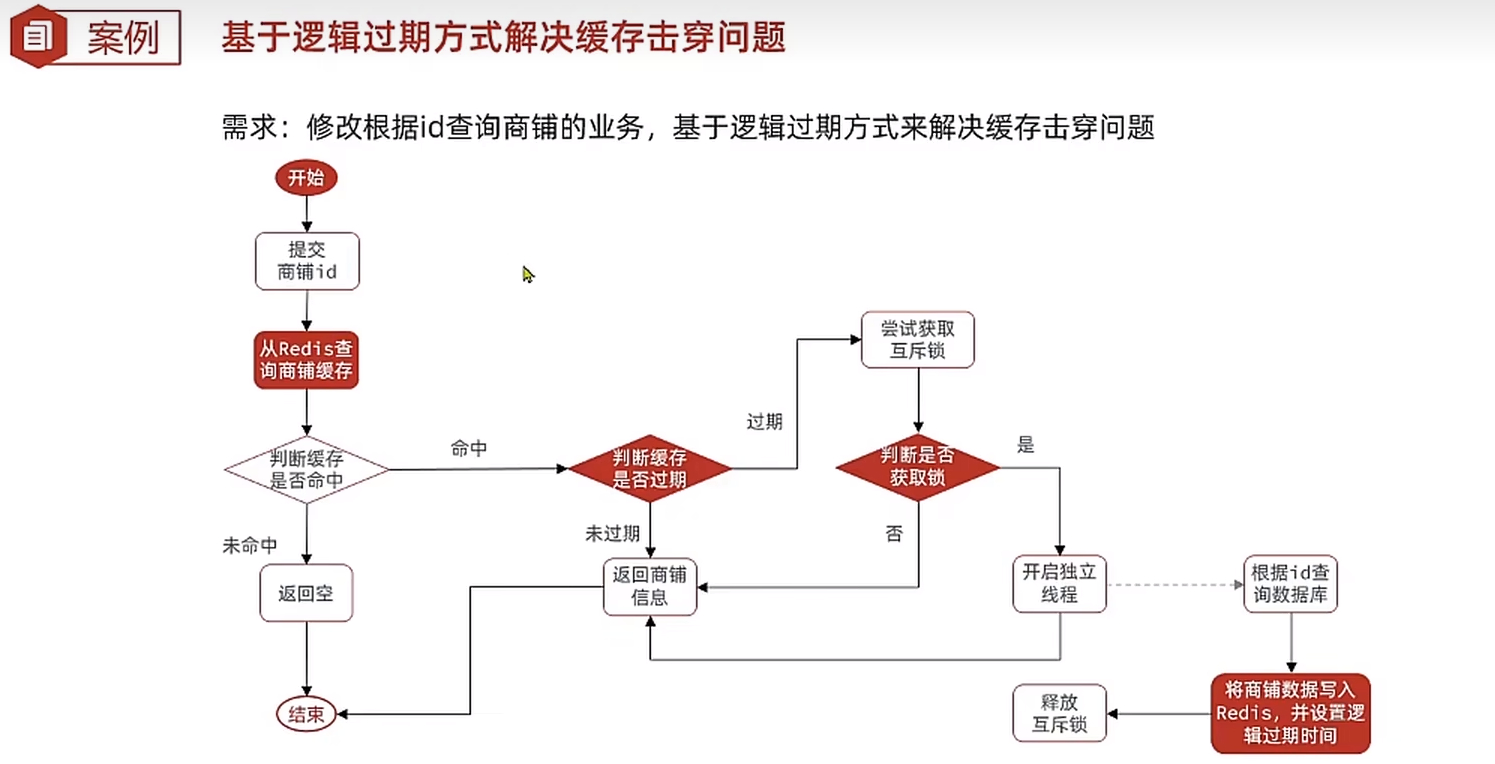
为了能增加一个逻辑过期时间的字段,新建一个对象
@Data
public class RedisData {private LocalDateTime expireTime;private Object data;
}代码修改
@Service
public class ShopServiceImpl extends ServiceImpl<ShopMapper, Shop> implements IShopService {@Resourceprivate StringRedisTemplate stringRedisTemplate;@Overridepublic Result queryById(Long id) {//缓存穿透//Shop shop=queryWithPassThrouh(id);//互斥锁解决缓存击穿
// Shop shop = queryWithMutex(id);//逻辑过期解决缓存击穿问题Shop shop = queryWithLogicalExpire(id);if(shop==null){return Result.fail("店铺不存在!");}//7.返回return Result.ok(shop);}private static final ExecutorService CACHE_REBUILD_EXECUTOR= Executors.newFixedThreadPool(10);public Shop queryWithLogicalExpire(Long id){String key=CACHE_SHOP_KEY+ id;//1.从Redis查询缓存String shopJson = stringRedisTemplate.opsForValue().get(key);//2.判断是否存在if (StrUtil.isBlank(shopJson)) {//3.存在,直接返回nullreturn null;}//4.命中,需要先把json反序列化为对象RedisData redisData = JSONUtil.toBean(shopJson, RedisData.class);Shop shop = JSONUtil.toBean((JSONObject)redisData.getData(), Shop.class);LocalDateTime expireTime = redisData.getExpireTime();//5.判断是否过期if(expireTime.isAfter(LocalDateTime.now())){//5.1未过期,直接返回店铺信息return shop;}//5.2已过期,需要缓存重建//6.缓存重建//6.1获取互斥锁String lockKey=LOCK_SHOP_KEY+id;boolean isLock = tryLock(lockKey);//6.2判断是否获取锁成功if(isLock){//这里应该再次检测缓存是否过期,做双重判断,如果没过期就不需重建了,因为可能别的线程已经重建了shopJson = stringRedisTemplate.opsForValue().get(key);redisData = JSONUtil.toBean(shopJson, RedisData.class);expireTime = redisData.getExpireTime();if(expireTime.isAfter(LocalDateTime.now())){//返回前先释放锁unlock(lockKey);//5.1未过期,直接返回店铺信息return shop;}//6.3成功,开启独立线程,实现缓存重建CACHE_REBUILD_EXECUTOR.submit(()->{try {//重建缓存this.saveShop2Redis(id,20L);} catch (Exception e) {throw new RuntimeException(e);} finally {//释放锁unlock(lockKey);}});}//6.4失败,返回过期商铺信息。return shop;}public Shop queryWithMutex(Long id){String key=CACHE_SHOP_KEY+ id;//1.从Redis查询缓存String shopJson = stringRedisTemplate.opsForValue().get(key);//2.判断是否存在if (StrUtil.isNotBlank(shopJson)) {//3.存在,直接返回return JSONUtil.toBean(shopJson, Shop.class);}//判断命中的是否是空值if(shopJson!=null){//返回一个错误信息return null;}//4.实现缓存重建//4.1获取互斥锁String lockkey="lock:shop:"+id;Shop shop = null;try {boolean isLock = tryLock(lockkey);//4.2判断是否获取成功if(!isLock){//4.3失败,休眠并重试Thread.sleep(50);return queryWithMutex(id); //这里有可能会出现栈溢出的情况。}//获取成功之后应该再次检查缓存是否存在,有可能别的线程已经重建完了缓存,所以这里就无需再重建缓存shopJson = stringRedisTemplate.opsForValue().get(key);//再次判断是否存在if (StrUtil.isNotBlank(shopJson)) {//存在,直接返回return JSONUtil.toBean(shopJson, Shop.class);}//4.4根据id查询数据库shop = getById(id);//模拟重建的延时//Thread.sleep(200);if (shop==null) {//将空值写入RedisstringRedisTemplate.opsForValue().set(key,"",CACHE_NULL_TTL, TimeUnit.MINUTES);//5.不存在,返回错误return shop;}//6.存在,写入RedisstringRedisTemplate.opsForValue().set(key,JSONUtil.toJsonStr(shop),CACHE_SHOP_TTL, TimeUnit.MINUTES);} catch (InterruptedException e) {throw new RuntimeException(e);} finally {//7.释放互斥锁unlock(lockkey);}//8.返回return shop;}public Shop queryWithPassThrouh(Long id){String key=CACHE_SHOP_KEY+ id;//1.从Redis查询缓存String shopJson = stringRedisTemplate.opsForValue().get(key);//2.判断是否存在if (StrUtil.isNotBlank(shopJson)) {//3.存在,直接返回Shop shop = JSONUtil.toBean(shopJson, Shop.class);return shop;}//判断命中的是否是空值if(shopJson!=null){//返回一个错误信息return null;}//4.不存在,根据id查询数据库Shop shop = getById(id);if (shop==null) {//将空值写入RedisstringRedisTemplate.opsForValue().set(key,"",CACHE_NULL_TTL, TimeUnit.MINUTES);//5.不存在,返回错误return shop;}//6.存在,写入RedisstringRedisTemplate.opsForValue().set(key,JSONUtil.toJsonStr(shop),CACHE_SHOP_TTL, TimeUnit.MINUTES);//7.返回return shop;}private boolean tryLock(String key){Boolean flag = stringRedisTemplate.opsForValue().setIfAbsent(key, "1", 10, TimeUnit.SECONDS);return BooleanUtil.isTrue(flag);}private void unlock(String key){stringRedisTemplate.delete(key);}public void saveShop2Redis(Long id,Long expireSeconds) throws InterruptedException {//1.查询店铺数据Shop shop = getById(id);//模拟延时
// Thread.sleep(200);//2.封装逻辑过期时间RedisData redisData = new RedisData();redisData.setData(shop);redisData.setExpireTime(LocalDateTime.now().plusSeconds(expireSeconds));//3.写入RedisstringRedisTemplate.opsForValue().set(CACHE_SHOP_KEY+id,JSONUtil.toJsonStr(redisData));}@Overridepublic Result update(Shop shop) {Long id = shop.getId();if(id==null){return Result.fail("店铺id不能为空");}//1.更新数据库updateById(shop);//2.删除缓存stringRedisTemplate.delete(CACHE_SHOP_KEY+id);return null;}
}
缓存工具封装(重点)

封装工具类里用到的实体
@Data
public class RedisData {private LocalDateTime expireTime;private Object data;
}
工具类代码
@Slf4j
@Component
public class CacheClient {@Resourceprivate StringRedisTemplate stringRedisTemplate;String LOCK_SHOP_KEY="lock:shop:";public CacheClient(StringRedisTemplate stringRedisTemplate) {this.stringRedisTemplate = stringRedisTemplate;}public void set(String key, Object value, Long time, TimeUnit timeUnit){stringRedisTemplate.opsForValue().set(key, JSONUtil.toJsonStr(value),time,timeUnit);}public void setWithLogicalExpire(String key, Object value, Long time, TimeUnit timeUnit){//设置逻辑过期RedisData redisData = new RedisData();redisData.setData(value);redisData.setExpireTime(LocalDateTime.now().plusSeconds(timeUnit.toSeconds(time)));//写入RedisstringRedisTemplate.opsForValue().set(key, JSONUtil.toJsonStr(redisData));}public <R,ID> R queryWithPassThrough(String keyPrefix, ID id, Class<R> type, Function<ID,R>dbFallback, Long time, TimeUnit timeUnit){String key=keyPrefix+id;//1.从Redis查询缓存String json = stringRedisTemplate.opsForValue().get(key);//2.判断是否存在if (StrUtil.isNotBlank(json)) {//3.存在,直接返回return JSONUtil.toBean(json, type);}//判断命中的是否是空值if(json!=null){//返回一个错误信息return null;}//4.不存在,根据id查询数据库R r=dbFallback.apply(id);//5.不存在,返回错误if (r==null) {//将空值写入RedisstringRedisTemplate.opsForValue().set(key,"",2L, TimeUnit.MINUTES);return null;}//6.存在,写入Redisthis.set(key,r,time,timeUnit);//7.返回return r;}private static final ExecutorService CACHE_REBUILD_EXECUTOR= Executors.newFixedThreadPool(10);public <R,ID> R queryWithLogicalExpire(String keyPrefix, ID id, Class<R> type, Function<ID,R>dbFallback, Long time, TimeUnit timeUnit){String key=keyPrefix+ id;//1.从Redis查询缓存String json = stringRedisTemplate.opsForValue().get(key);//2.判断是否存在if (StrUtil.isBlank(json)) {//3.存在,直接返回nullreturn null;}//4.命中,需要先把json反序列化为对象RedisData redisData = JSONUtil.toBean(json, RedisData.class);R r = JSONUtil.toBean((JSONObject)redisData.getData(), type);LocalDateTime expireTime = redisData.getExpireTime();//5.判断是否过期if(expireTime.isAfter(LocalDateTime.now())){//5.1未过期,直接返回店铺信息return r;}//5.2已过期,需要缓存重建//6.缓存重建//6.1获取互斥锁String lockKey=LOCK_SHOP_KEY+id;boolean isLock = tryLock(lockKey);//6.2判断是否获取锁成功if(isLock){//这里应该再次检测缓存是否过期,做双重判断,如果没过期就不需重建了,因为可能别的线程已经重建了json = stringRedisTemplate.opsForValue().get(key);redisData = JSONUtil.toBean(json, RedisData.class);r = JSONUtil.toBean((JSONObject)redisData.getData(), type);expireTime = redisData.getExpireTime();if(expireTime.isAfter(LocalDateTime.now())){//返回前先释放锁unlock(lockKey);//5.1未过期,直接返回店铺信息return r;}//6.3成功,开启独立线程,实现缓存重建CACHE_REBUILD_EXECUTOR.submit(()->{try {//重建缓存//查询数据库R r1 = dbFallback.apply(id);//写入Redisthis.setWithLogicalExpire(key,r1,time,timeUnit);} catch (Exception e) {throw new RuntimeException(e);} finally {//释放锁unlock(lockKey);}});}//6.4失败,返回过期信息。return r;}private boolean tryLock(String key){Boolean flag = stringRedisTemplate.opsForValue().setIfAbsent(key, "1", 10, TimeUnit.SECONDS);return BooleanUtil.isTrue(flag);}private void unlock(String key){stringRedisTemplate.delete(key);}
}Service层修改后代码
里面有缓存穿透的调用,也有缓存击穿的调用.
@Service
public class ShopServiceImpl extends ServiceImpl<ShopMapper, Shop> implements IShopService {@Resourceprivate StringRedisTemplate stringRedisTemplate;@Resourceprivate CacheClient cacheClient;@Overridepublic Result queryById(Long id) {//缓存穿透Shop shop=cacheClient.queryWithPassThrough(CACHE_SHOP_KEY,id, Shop.class,id2->getById(id2),CACHE_SHOP_TTL,TimeUnit.MINUTES);//Shop shop=cacheClient.queryWithPassThrough(CACHE_SHOP_KEY,id, Shop.class,this::getById,,CACHE_SHOP_TTL,TimeUnit.MINUTES);//互斥锁解决缓存击穿//Shop shop = queryWithMutex(id);//逻辑过期解决缓存击穿问题
// Shop shop = cacheClient
// .queryWithLogicalExpire(CACHE_SHOP_KEY,id,Shop.class,this::getById,CACHE_SHOP_TTL,TimeUnit.SECONDS);if(shop==null){return Result.fail("店铺不存在!");}//7.返回return Result.ok(shop);}@Overridepublic Result update(Shop shop) {Long id = shop.getId();if(id==null){return Result.fail("店铺id不能为空");}//1.更新数据库updateById(shop);//2.删除缓存stringRedisTemplate.delete(CACHE_SHOP_KEY+id);return null;}
}内容总结:
去看文档资料里面xmind文档,那个里面总结的很好。
这篇关于Redis——某马点评day02——商铺缓存的文章就介绍到这儿,希望我们推荐的文章对编程师们有所帮助!
